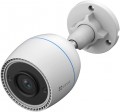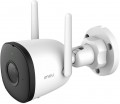Max. memory card size
The largest capacity of a memory card with which a video surveillance camera can work correctly.
High-capacity drives require fairly high processing power and may use special technologies that are not supported by all cameras. This is the reason for the limitation on the volume of supported media.
Smart home system integration
Smart home systems that the camera is compatible with.
The general principle of all such systems is to combine various home electronics and household electrical appliances into a single complex so that all these devices can interact with each other and jointly respond to various events. As for surveillance cameras specifically, their functions in a “smart home” are mainly related to reacting to movement in the frame and broadcasting video. For example, a compatible camera can send a notification to the user’s smartphone when a motion sensor is triggered, or transmit video to a TV integrated into the home network.
Nowadays you can find different smart home platforms, the most popular are Apple HomeKit, Google Home, Amazon Alexa. However, there are other options for branded systems - as a rule, they are sold by manufacturers for their smart home and video surveillance devices. To fully work in a particular system, it is worth using cameras that have expressly stated appropriate compatibility. Also, when purchasing a compatible model, it would not hurt to clarify its specific functionality related to the “smart home”.
Matrix size
The size of the matrix installed in the surveillance camera (diagonally).
In general, larger sensors (with the same resolution and sensor type) are considered more advanced: they get more light, which has a positive effect on image quality (especially in low light). On the other hand, increasing the size affects the cost of the entire device; and in some cases (for example, if the camera is not planned to be used in twilight and darkness), a relatively small sensor may be quite suitable.
As for specific dimensions, the most modest cameras in terms of this indicator have matrices of
1/4 "or less. Models with sensors of
1/3.8" - 1/3" and
1/2.9" - 1/2" are very popular, these values can be called average. And in advanced devices, diagonals and
more than 1/2 "(up to 1/1.7") are found.
Frame rate
The maximum frame rate in the video captured by the camera.
The higher the frame rate, the clearer the image, the less noticeable blurring when moving in the frame (especially fast). On the other hand, this indicator affects the amount of information recorded during shooting, as well as the cost of the camera itself. Therefore, it makes sense to specifically look for
a video surveillance camera with high-speed shooting(45 fps and higher) only if a clear recording of fast moving objects is important to you.
Minimum illumination
The lowest degree of illumination of the scene being shot, in which the camera is able to provide normal visibility. Usually, this item specifies the values for the daytime mode of operation (in the night mode, the minimum illumination in many models may be zero at all, because in such cases the IR illumination is turned on, see "Design and capabilities"). And if the camera is capable of shooting in colour, it usually means the lowest illumination necessary to obtain a colour image.
The lower this indicator, the better the camera works in low light, the brighter and more clearly visible image it is able to provide in such conditions. At the same time, note that in low light, night mode is often preferable, and in the presence of the aforementioned IR illumination, it is more likely to focus on the range of its operation (see above).
There are comparative tables that allow you to evaluate the degree of illumination indicated in the characteristics from a practical point of view: for example, an indicator of 0.2 lux corresponds to clear eyes on a full moon.
Aperture
Aperture of the lens installed in the camera.
Aperture characterizes the degree of attenuation of the light flux when passing from the front lens of the lens to the matrix. It is denoted as the ratio of the diameter of the active aperture of the lens to the focal length, while the size of the active aperture is designated as f and is taken as a unit — for example, f / 1.4 or f / 2.0. Moreover, the smaller the number in the designation, the higher the aperture (in our example, the second lens will be darker than the first). And for lenses with a variable focal length (see "Focal"), the actual aperture, usually, changes with a change in focal length; for such models, either the range of aperture values, or its maximum value, can be indicated.
By itself, this parameter characterizes, first of all, how light the image taken through the lens turns out, all other things being equal. High values are important, first of all, when shooting in low light conditions: a fast lens allows you to get a fairly high-quality image without increasing the sensitivity of the matrix, which is fraught with noise and “blurring” of the picture. On the other hand, the actual quality of camera operation (including in dark conditions) also depends on many other factors — the type and size of the matrix, signal processing features, etc. Therefore, aperture in most cases is more of a reference than a practically significant parameter.
Backlight compensation
—
WDR (Wide Dynamic Range) — extended dynamic range. WDR technology combines several frames with different exposures into one picture, as a result, dark areas are brightened, and overexposures are darkened, and the output is a picture with extremely uniform lighting. The true wide dynamic range technology is called True-WDR and it is implemented in the optical circuit at the hardware level, a special microprocessor is responsible for creating and mixing exposures. A more affordable alternative to wide dynamic range is Digital-WDR technology, which equalizes lighting through software algorithms.
—
DWDR (Digital Wide Dynamic Range) — extended dynamic range technology based on software brightening algorithms. DWDR brightens too dark areas of the frame, which can be completely blurred against the background of light areas. Digital brightening allows you to noticeably improve the quality of shooting in contrasting lighting conditions. Digital WDR cameras are noticeably cheaper than true True-WDR optics. Of course, the quality of digital brightening is inferior to True-WDR.
—
BLC (Back Light Compensation) — backlight compensation technology. This system is based on the work of digital signal processors DSP. So, the device, relatively speaking, "breaks" the frame into many segments, making its own adjustments to each of them. Backlight compensation brightens dark areas of
...the frame well. The main disadvantage of the technology is the increase in the brightness of the already bright areas of the frame, due to which overexposure may appear in the picture.
— WDR+BLC. The camcorder supports several lightening technologies at once, each of which is described in more detail above. Immediately, we note that the combination of WDR + BLC allows you to achieve an extremely clear and clear picture in almost any lighting conditions, from extreme contrast to insufficient and excessively bright.
— DWDR+BLC. The device supports two popular clarification technologies at once, each of which is described in more detail above. The presence of DWDR + BLC technologies allows the camera to effectively brighten the dark areas of the frame. Such video cameras have proven themselves well when working in low light conditions.Focal length
Focal length of the camera lens.
The focal length is such a distance from the lens to the matrix, at which a clear image is obtained on the matrix (when the lens is focused to infinity). The viewing angles of the lens primarily depend on this indicator (see below): the smaller it is, the wider the viewing angles and the smaller the objects in the frame (and vice versa). At the same time, it should be noted that the actual viewing angle is determined not only by the focal length, but also by the size of the matrix (see above). In fact, this means that with different sizes of matrices, lenses with the same focal length will have different working angles. Therefore, only cameras with the same matrix size can be compared with each other according to this indicator. Among CCTV cameras, lenses with a focal length of
2.8 mm,
3.6 mm,
4 mm and
6 mm are considered popular.
In models with a variable focal length (see above), in this case, the range from the minimum to the maximum distance is indicated. Also, using these data, you can derive the optical magnification factor of such a lens: for this, the maximum value must be divided by the maximum (for more details, see below).
Horizontal viewing angle
Horizontal viewing angle of the surveillance camera. For models with a variable value, the maximum value is indicated, since it is the width of the image that is important, and when zooming in, the zoom factor is more important than the angle. This paragraph also indicates the general angle of view for models with a circular field of view – in particular, cameras with a fisheye lens (see above)
The wider the viewing angle, the more space the camera captures and at the same time, the smaller the images of individual objects in the frame are obtained. Therefore, when choosing by this parameter, it is worth deciding what is more important – the ability to view a large scene or the visibility of small details in a relatively narrow field of view. Also note that with a wide field of view (100° or more), characteristic distortions can be observed at the edges of the frame, and the wider the angle, the more pronounced they are. This phenomenon can be eliminated by panoramic shooting (see "Design and features"), but this feature, in turn, complicates and increases the cost of the camera.

